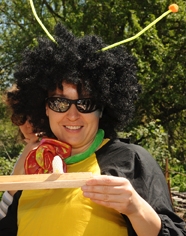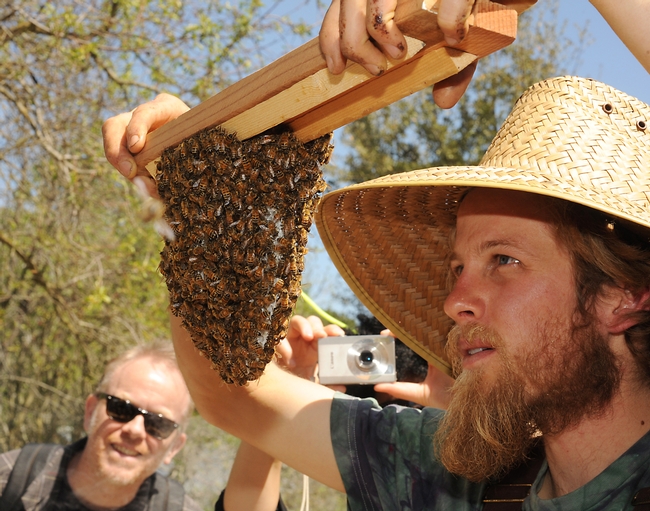
After rain postponed the grand opening of the Davis Bee Collective's Bee Sanctuary not once, but twice--the third time, Sunday, April 1--proved to be “the charm.”
Derek Downey, who coordinates the Bee Collective and the Bee Sanctuary and is also known as “The Davis Bee Charmer,” praised the huge turnout at the sanctuary, which is located on Orchard Park Drive, near the Domes student housing.
The visitors, quite enthusiastic, "wanted to learn about keeping bees in top bar hives, providing habitat for native bees, creating hugelkulter gardening beds, creating odor-free no-turn compost piles, and propagating plants by cuttings," Downey said.
Participants helped "create beautiful painted signs for the garden, helped finish digging more hugelkulter garden beds, wrote love letters to the bees (to be buried in time capsule in garden), and offered donations to the Davis Bee Collective, including a shed," Downey noted.
Extension apiculturist Eric Mussen of the UC Davis Department of Entomology discussed native bees, including bumble bees, carpenter bees and leafcutting bees, and also answered questions on honey bees. European colonists brought honey bees to what is now the United States in 1622.
Beekeeper Elizabeth Frost, staff research associate at the Harry H. Laidlaw Jr. Honey Bee Research Facility at UC Davis, displayed an observation hive and fielded questions about honey bees, including how long they live and what they need to survive. “A queen bee can live two to three years,” she said, “but most commercial beekeepers requeen their hive every year.”
As Frost talked, the queen bee in the observation hive continued to lay eggs. “In the peak season, she can lay 2000 eggs as day,” Frost said.
The event also included a potluck, honey tasting (more than 10 flavors) and an information table featuring resources on keeping bees and lists of bee friendly plants.
The hives in the sanctuary are lettered with such names as "Just Bee," "Bee Happy," "Birdhouse" and "the Whaler Superorganism."
For the occasion, first-year beekeeper Eva Dopico, a second grade teacher at Cesar Chavez Elementary School, Davis, dressed as a bee.
Downey, a UC Davis engineering graduate, invites interested persons to join the Bee Collective and Bee Sanctuary; information on how to join is on the Davis Wiki website.
He moderates the Google group and adds new members. "If someone wants to just help out and learn about bees, they are always welcome to take part," he said. "We will have hives that are collectively managed so everyone can learn together. If someone wants to keep their own hive there, it is first-come, first served. We have space for 10 to 12 hives, max."??
Members of the Bee Collective, a community-based group founded in 2005 by former UC Davis entomology graduate student Eli Sarnat, share resources, such as beekeeping equipment, books, and tools. Downey accepts donations for the Bee Collective and Bee Sanctuary (contact him at davisbeecharmers@gmail.com or (310) 694-2405.)
Bee Sanctuary work parties are held every Sunday from 1 to 4 p.m. at the site. Downey anticipates filling the other empty hives in the sanctuary via swarms he collects in Davis, Dixon, Sacramento, Woodland, and Winters.
Attached Images:

Derek Downey checks the cluster on a newly hived colony. (Photo by Kathy Keatley Garvey)

First-year beekeeper Eva Dopico, a second-grade teacher in Davis, examines one of her newly emerged bees. (Photo by Kathy Keatley Garvey)

Beekeeper Elizabeth Frost (facing camera), a staff research associate at UC Davis, brought along a bee observation hive. (Photo by Kathy Keatley Garvey)